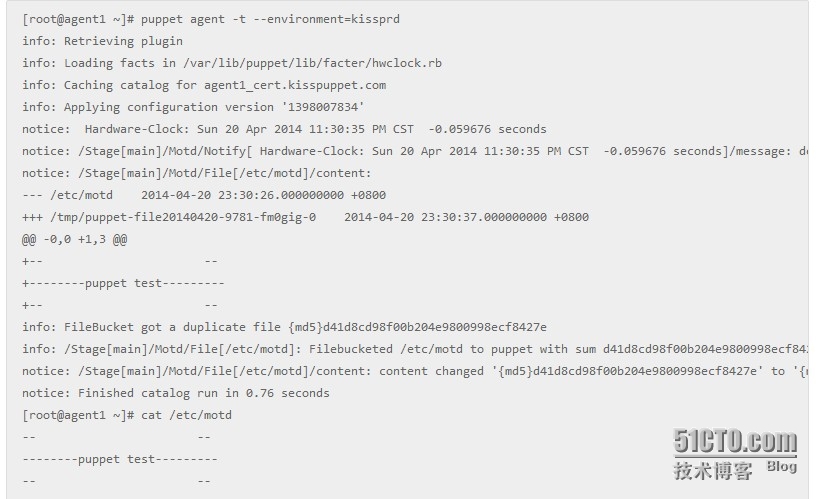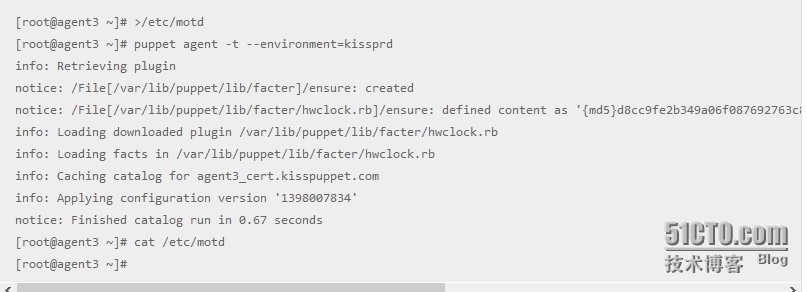零基础学习Puppet自动化配置管理系列文档
在大量节点加入Puppet之后,你至少会面临两个比较大的问题:
1、由于节点数的增多,site.pp文件必然会编写更多的节点条目,以及节点包含的类。假设你用Puppet管理500个节点,存在三种情况:1、所有节点有共同的类,也可以理解为模块;2、所有节点分成了50组,每组节点有不同的应用,每组应用编写一个模块;3、每个节点也应该有一个自己的模块,在这种环境下,可想而知,site.pp文件是多么的复杂,多么的难以维护。
2、在使用MCO推送更新的时候,后面可以跟上fact变量用于过滤一组节点。而官方给的facter只能满足普遍存在的fact变量,可是,你要对一组节点进行归类怎么办呢,比如有10个节点的应用是Apache,15个节点属于Nginx等,那么就要自定义fact变量。现在面临的问题是,所有节点都要自定义fact变量,又如何做到集中管理呢?
一、先来解决节点与类结合的问题
其实、节点与类之间的结合,更多时候是要借助ENC(外部节点分类器)来完成,因为puppet软件本身并不具备此类功能。Puppet-dashboard企业版和Foreman已经具备了这方面的功能,而且是图形界面操作,还是很方便的。众所周知,Puppet-dashboard社区版目前最新版本为1.2.23,到目前为止已经有一年多未更新了,可见Puppetlabs的意图很明确,逼着你用企业版。而Foreman部署和使用略复杂些,其次Foreman很重,它的内部并不仅仅是包含puppet还包含了很多其它管理工具,非常庞大,可以酌情考虑使用。接下来要介绍的是官方推荐的hiera软件,一个很强大的ENC,编写的文件只要遵循yaml格式即可,使用非常方便,可惜的是没有图形界面。但这并不代表你不会开发图形界面哦。
1、在Master端安装hiera工具
hiera工具和Puppetmaster结合需要通过hiera-puppet工具完成,在puppet-server 3.0.*版本后,这个工具已经集成到了puppet-server安装包中。而我们现在使用的环境仍然是puppet2.7版本,所以需要安装hiera-puppet工具。
|
1
2
3
4
5
6
7
8
9
10
11
12
13
14
15
16
17
|
[root@puppetmaster RHEL6U4]
# yum install hiera hiera-puppet #注意依赖关系
...
Dependencies Resolved
===========================================================================
Package Arch Version Repository Size
===========================================================================
Installing:
hiera noarch 1.3.2-1.el6 rhel-puppet 23 k
hiera-puppet noarch 1.0.0-1.el6 rhel-puppet 14 k
Installing fordependencies:
ruby-irb x86_64 1.8.7.352-7.el6_2 rhel-base 311 k
ruby-rdoc x86_64 1.8.7.352-7.el6_2 rhel-base 375 k
rubygem-json x86_64 1.5.5-1.el6 rhel-puppet 763 k
rubygems noarch 1.3.7-1.el6 rhel-puppet 206 k
Transaction Summary
===========================================================================
...
|
2、编辑hiera主配置文件hiera.yaml
2.1、创建软连接
默认hiera.yaml主配置文件在/etc目录下,为了结合后期版本控制系统集中管理,建议将此文件copy到/etc/puppet目录下,然后创建软连接指向/etc/hiera.yaml即可。
|
1
2
3
4
|
[root@puppetmaster ~]# mv /etc/hiera.yaml /etc/puppet/
[root@puppetmaster ~]# ln -s /etc/puppet/hiera.yaml /etc/hiera.yaml
[root@puppetmaster ~]# ll /etc/hiera.yaml
lrwxrwxrwx 1root root 22Apr
2020
:
05
/etc/hiera.yaml -> /etc/puppet/hiera.yaml
|
2.2、编辑hiera.yaml
-
添加全局变量common,注释掉defaults、global和clientcert。
-
添加系统类型变量osfamily
-
添加主机名变量hostname
-
添加datadir路径位置,中间用了puppet环境变量,这里的环境变量和puppet应用的环境变量是一致的。如果你只有一种环境,只需要将其中变量去掉即可。
备注: 以上变量其实就是fact变量。
|
1
2
3
4
5
6
7
8
9
10
11
12
13
14
|
[root@puppetmaster ~]# vim /etc/puppet/hiera.yaml
---
:backends:
- yaml
:hierarchy:
# - defaults
# -
"%{clientcert}"
- common
-
"%{environment}"
-
"%{osfamily}"
-
"%{hostname}"
# - global
:yaml:
:datadir:
"/etc/puppet/environments/%{environment}/hiera"
|
hiera主配置文件编写完成之后,需要重启puppetmaster后方可生效。
|
1
2
3
|
[root@puppetmaster hiera]# /etc/init.d/puppetmaster restart
Stopping puppetmaster: [ OK ]
Starting puppetmaster: [ OK ]
|
2.3、创建变量common对应的文件
|
1
2
3
4
|
[root@puppetmaster hiera]# vim common.yaml
---
puppetserver:
-
'puppetmaster.kisspuppet.com'
|
通过hiera命令测试
|
1
2
3
4
|
[root@puppetmaster ~]# hiera puppetserver environment=kissprd
[
"puppetmaster.kisspuppet.com"
]
[root@puppetmaster ~]# hiera puppetserver environment=kissdev
nil
|
通过以上命令可以得知在环境为kissprd的情况下,puppetserver的变量为puppetmaster.kisspuppet.com,值为nil的意思是不存在。
2.4、创建变量osfamily对应的文件
|
1
2
3
4
5
6
7
|
[root@agent1 ~]# facter osfamily
RedHat
[root@puppetmaster hiera]# vim RedHat.yaml
---
classes:
-
'puppet'
-
'yum'
|
通过hiera命令测试
|
1
2
3
4
5
6
|
[root@puppetmaster hiera]# hiera classes environment=kissprd
nil
[root@puppetmaster hiera]# hiera classes environment=kissprd osfamily=RedHat
[
"motd"
,
"puppet"
,
"yum"
]
[root@puppetmaster hiera]# hiera classes environment=kissprd osfamily=SLES
nil
|
通过以上命令可以得在环境为kissprd,系统为RedHat的情况下,classes的变量为三个值(puppet、yum)。
2.5、创建变量hostname对应的所有节点文件
|
1
2
3
4
5
6
7
8
9
10
11
12
13
14
15
16
17
18
|
[root@agent1 ~]# facter hostname
agent1
[root@puppetmaster hiera]# vim agent1.yaml
---
classes:
-
'motd'
certname:
-
'agent1_cert.kisspuppet.com'
[root@puppetmaster hiera]# vim agent2.yaml
---
classes:
-
'motd'
certname:
-
'agent2_cert.kisspuppet.com'
[root@puppetmaster hiera]# vim agent3.yaml
---
certname:
-
'agent3_cert.kisspuppet.com'
|
通过hiera命令测试
|
1
2
3
4
5
6
7
8
9
10
11
12
13
14
15
|
[root@puppetmaster hiera]# hiera classes environment=kissprd hostname=agent
1
[
"motd"
]
[root@puppetmaster hiera]# hiera classes environment=kissprd hostname=agent
2
[
"motd"
]
[root@puppetmaster hiera]# hiera classes environment=kissprd hostname=agent
3
nil
[root@puppetmaster hiera]# hiera certname environment=kissprd hostname=agent1
[
"agent1_cert.kisspuppet.com"
]
[root@puppetmaster hiera]# hiera certname environment=kissprd hostname=agent2
[
"agent2_cert.kisspuppet.com"
]
[root@puppetmaster hiera]# hiera certname environment=kissprd hostname=agent3
[
"agent3_cert.kisspuppet.com"
]
|
通过以上命令测试可以得知,系统fact变量hostname为agent1和agent2的情况下,hiera变量classes为motd。certname变量为各自的certname变量。
3、应用hiera变量于Puppetmaster
3.1、将hiera变量应用于site.pp文件中
以前的写法:
|
1
2
3
4
5
6
7
8
9
10
11
12
13
14
15
16
17
|
[root@puppetmaster ~]# vim /etc/puppet/environments/kissprd/manifests/site.pp
$puppetserver =
'puppetmaster.kisspuppet.com'
classenvironments{
includepuppet,yum
}
node
'puppetmaster_cert.kisspuppet.com'
{
includeenvironments
}
node
'agent1_cert.kisspuppet.com'
{
includeenvironments,motd
}
node
'agent2_cert.kisspuppet.com'
{
includeenvironments,motd
}
node
'agent3_cert.kisspuppet.com'
{
includeenvironments
}
|
应用了hiera之后的写法:
|
1
2
3
4
5
|
[root@puppetmaster ~]# vim /etc/puppet/environments/kissprd/manifests/site.pp
$puppetserver = hiera(
'puppetserver'
) #引用了hiera中common.yaml中的全局变量puppetserver
node
default
{
hiera_include(
'classes'
) #引用了hiera中osfamily和hostname变量
}
|
备注:以后添加节点,只需要编写yaml文件即可,而site.pp文件无需在进行修改。
3.2、将hiera变量应用于模块puppet中
未使用hiera之前的编写方式
|
1
2
3
4
5
6
7
8
9
10
11
12
13
14
15
16
17
18
|
[root@puppetmaster hiera]# vim /etc/puppet/environments/kissprd/environment/modules/puppet/manifests/params.pp
classpuppet::params {
$puppetserver =
'puppetmaster.kisspuppet.com'
$certname =
"${::hostname}_cert.kisspuppet.com"
case
$operatingsystemmajrelease{
5
: {
$puppet_release =
'2.7.23-1.el5'
$facter_release =
'1.7.3-1.el5'
}
6
: {
$puppet_release =
'2.7.23-1.el6'
$facter_release =
'1.7.3-1.el6'
}
default
: {
fail(
"Module puppet is not supported on ${::operatingsystem}"
)
}
}
}
|
应用了hiera变量之后的编写方式
|
1
2
3
4
5
6
7
8
9
10
11
12
13
14
15
16
17
18
|
[root@puppetmaster hiera]# vim /etc/puppet/environments/kissprd/environment/modules/puppet/manifests/params.pp
classpuppet::params {
$puppetserver = hiera(
'puppetserver'
) #应用了hiera全局文件common.yaml中的puppetserver变量
$certname = hiera(
'certname'
) #应用了hiera中变量hostname对应的节点文件$hostname.yaml中的certname变量
case
$operatingsystemmajrelease{
5
: {
$puppet_release =
'2.7.23-1.el5'
$facter_release =
'1.7.3-1.el5'
}
6
: {
$puppet_release =
'2.7.23-1.el6'
$facter_release =
'1.7.3-1.el6'
}
default
: {
fail(
"Module puppet is not supported on ${::operatingsystem}"
)
}
}
}
|
4、测试
4.1、测试classes
4.2、测试hiera变量certname和puppetserver
|
1
2
3
4
5
6
7
8
9
10
11
12
13
14
15
16
17
18
19
20
21
22
23
24
25
26
27
28
29
30
31
32
33
34
35
36
37
38
39
40
41
42
43
44
45
46
47
48
49
50
|
[root@agent3 ~]# vim /etc/puppet/puppet.conf
### config by puppet ###
[main]
logdir = /
var
/log/puppet
rundir = /
var
/run/puppet
ssldir = $
var
dir/ssl
pluginsync =
true
[agent]
classfile = $
var
dir/classes.txt
localconfig = $
var
dir/localconfig
# server = puppetmaster.kisspuppet.com #注释掉进行测试
# certname = agent3_cert.kisspuppet.com
runinterval =
10
[root@agent3 ~]# puppet agent -t --environment=kissprd --server=puppetmaster.kisspuppet.com --certname=agent3_cert.kisspuppet.com
info: Retrieving plugin
info: Loading facts
in
/
var
/lib/puppet/lib/facter/hwclock.rb
info: Caching catalog foragent3_cert.kisspuppet.com
info: Applying configuration version
'1398008880'
notice: /Stage[main]/Puppet::Config/File[/etc/puppet/puppet.conf]/content:
--- /etc/puppet/puppet.conf
2014
-
04
-
2023
:
46
:
05.839948111
+
0800
+++ /tmp/puppet-file20140420-
5618
-45rytg-
02014
-
04
-
2023
:
48
:
01.653944253
+
0800
@@ -
7
,
6
+
7
,
6
@@
[agent]
classfile = $
var
dir/classes.txt
localconfig = $
var
dir/localconfig
-# server = puppetmaster.kisspuppet.com
-# certname = agent3_cert.kisspuppet.com
+ server = puppetmaster.kisspuppet.com
+ certname = agent3_cert.kisspuppet.com
runinterval =
10
info: FileBucket adding {md5}13430e5962e7584c9422e5adc1f3ba43
info: /Stage[main]/Puppet::Config/File[/etc/puppet/puppet.conf]: Filebucketed /etc/puppet/puppet.conf to puppet withsum 13430e5962e7584c9422e5adc1f3ba43
notice: /Stage[main]/Puppet::Config/File[/etc/puppet/puppet.conf]/content: content changed
'{md5}13430e5962e7584c9422e5adc1f3ba43'
to
'{md5}23545b7afd09af671920f122a20db952'
info: /Stage[main]/Puppet::Config/File[/etc/puppet/puppet.conf]: Scheduling refresh of Class[Puppet::Service]
info: Class[Puppet::Service]: Scheduling refresh of Service[puppet]
notice: /Service[puppet]: Triggered
'refresh'
from 1events
notice: Finished catalog run in0.54seconds
[root@agent3 ~]# cat /etc/puppet/puppet.conf
### config by puppet ###
[main]
logdir = /
var
/log/puppet
rundir = /
var
/run/puppet
ssldir = $
var
dir/ssl
pluginsync =
true
[agent]
classfile = $
var
dir/classes.txt
localconfig = $
var
dir/localconfig
server = puppetmaster.kisspuppet.com
certname = agent3_cert.kisspuppet.com
runinterval =
10
|
通过以上测试可以得知hiera变量certname和puppetserver传输正常。
特别说明: 由于hiera定义的变量需要通过转换才能变为puppet能够使用的变量,而这个转换是需要耗费CPU资源的,笔者曾经测试过一组节点(50个)同时传输hiera的变量数超过2000个,出现CPU负载过高的性能瓶颈问题需要特别注意。其次hiera数据除了用yaml格式保存外还可以存放在redis数据库中,这样查询起来性能会高很多,具体可参考官网,《pro puppet 》第二版也有这方面的介绍,可参阅。
通过以上测试至少解决了两个问题:
-
site.pp编写繁琐复杂的问题。
-
certname名定义问题(可以不适用其他fact变量进行定义,比如不再使用hostname变量,这样做的好处是即使节点hostname名变化也不会影响puppet通信)
二、集中管理自定义fact变量
思路: 参考Puppet基础篇10-自定义fact实现的四种方式介绍 在puppetmaster端编写一个facts模块,传输一个变量文件至节点对应的目录里面,变量文件名可以通过主机名进行定义。
1、在现有facts模块中直接添加
之前facts模块中的结构
|
1
2
3
4
5
6
7
8
9
|
[root@puppetmaster modules]# tree facts/
facts/
├── files
├── lib
│ └── facter
│ └── hwclock.rb #通过pluginsync模式发布的自定义fact变量,无需修改
├── manifests
└── templates
5directories, 1file
|
2、添加管理file资源的pp文件
|
1
2
3
4
5
6
7
8
9
10
11
12
13
14
15
16
17
18
19
20
21
22
|
[root@puppetmaster manifests]# vim config.pp #定义file资源
classfacts::config{
file{
"/etc/facter/facts.d/$hostname.txt"
: #文件名称通过变量hostname获取
owner =>
"root"
,
group =>
"root"
,
mode =>
0400
,
source =>
"puppet:///modules/facts/facts.d/$hostname.txt"
, #文件名称通过节点变量hostname获取
require => Class[
'facts::exec'
],
}
}
[root@puppetmaster manifests]# vim exec.pp #定义可执行资源保证目录 /etc/facter/facts.d 存在
classfacts::exec{
exec {
"create fact external"
:
command =>
"mkdir -p /etc/facter/facts.d "
,
path => [
"/usr/bin"
,
"/usr/sbin"
,
"/bin"
,
"/sbin"
],
creates =>
"/etc/facter/facts.d"
,
}
}
[root@puppetmaster manifests]# vim init.pp
classfacts{
includefacts::config,facts::exec
}
|
3、创建file资源对应的下载文件
|
1
2
3
4
5
6
7
8
9
10
11
|
[root@puppetmaster facts.d]# pwd
/etc/puppet/environments/kissprd/environment/modules/facts/files/facts.d
[root@puppetmaster facts.d]# vim agent1.txt
env=prd
app=weblogic
[root@puppetmaster facts.d]# vim agent2.txt
env=qa
app=db2
[root@puppetmaster facts.d]# vim agent3.txt
env=prd
app=nginx
|
4、应用模块facts至hiera中
由于模块facts属于全局的,应用于common.ymal或者RedHat.ymal中即可。
|
1
2
3
4
5
6
|
[root@puppetmaster hiera]# vim RedHat.yaml
---
classes:
-
'puppet'
-
'yum'
-
'facts'
|
5、节点测试
|
1
2
3
4
5
6
7
8
9
10
11
12
13
14
15
16
17
|
[root@agent3 ~]# ll /etc/facter/facts.d
ls: cannot access /etc/facter/facts.d: No such file or directory
[root@agent3 ~]# puppet agent -t --environment=kissprd
info: Retrieving plugin
info: Loading facts
in
/
var
/lib/puppet/lib/facter/hwclock.rb
info: Caching catalog foragent3_cert.kisspuppet.com
info: Applying configuration version
'1398010573'
notice: /Stage[main]/Facts::Exec/Exec[create fact external]/returns: executed successfully
notice: /Stage[main]/Facts::Config/File[/etc/facter/facts.d/agent3.txt]/ensure: defined content
as
'{md5}3330b8efe95f6747de47a9eca3a5411e'
notice: Finished catalog run in0.66seconds
[root@agent3 ~]# cat /etc/facter/facts.d/agent3.txt
env=prd
app=nginx
[root@agent3 ~]# facter env
prd
[root@agent3 ~]# facter app
nginx
|
其它节点测试略
注意:以上方法只是提供给你一种集中管理自定义fact的思路,并不是最好的解决方案,只不过这种方法目前笔者用于上产环境中感觉还不错,特此分享。
本文转自凌激冰51CTO博客,原文链接:http://blog.51cto.com/dreamfire/1399014,如需转载请自行联系原作者

